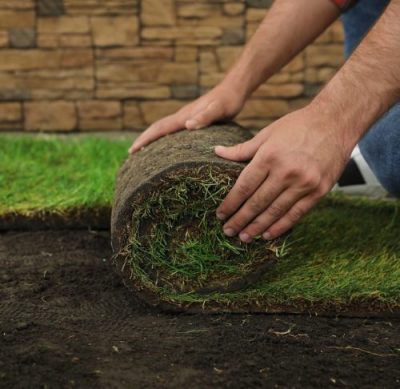- Lawn Turf
- Artificial
- Soil
- Timber
- Composite Decking
- Paving & Stone
Get In Touch With Our Experts Today!
Give us a Call! - Seed & Fertiliser
- Dressing
- Bark

December 01, 2017 Turf TipsWinter Tips
When you picture laying turf, you probably imagine a clear blue sky and gorgeous sunshine – not a chilly December day. There’s a perception that spring or summer is the best time to lay turf. However, autumn is considered a better time. And winter? Well, it’s just as good a time as any!
With proper preparation and care, you can achieve a lush, green lawn even in the colder months. If anything, you have more time to lay the perfect lawn while the rest of your garden rests.
In this article, we’ll cover the top tips for installing turf in winter, including:
Absolutely! Winter is a great time to install turf and is often recommended by turf growers and landscapers. Winter garden care usually involves fewer gardening tasks, so you can focus your efforts on creating a lush lawn. Furthermore, colder temperatures work to your advantage as there’s less chance of drought or scorching. During winter, the grass growth rate slows, so less watering is required, too. Better yet, the damp conditions provide an ideal environment for your turf to establish strong roots ready for spring.
There are only two factors to consider when laying turf in winter:

Believe it or not, frost isn’t damaging to turf. To have turf rolls freezing and defrosting is no different than if you were to defrost food items from your freezer at home. Frozen turf rolls can and do keep for a long time and can then be laid as normal once thawed. Whilst you cannot lay turf onto frozen ground, frosty weather once the turf has been laid isn’t a problem and will not cause any lifting or damage to your new grass. The advantage of cold weather is that prior to laying, the turf rolls last longer than during the summer months. So, you are under less time pressure to get them down.
View our range of premium turf, all ready to be laid this winter:
Laying turf in winter is no different to any other season. A successful lawn all comes down to proper ground preparation! Get this stage right, and the rest is easy. The bonus of laying turf in winter is the damper conditions often mean the soil is softer and easier to manage. Once your turf is down, you may not need to water it as much if rain is forecast. For a complete step-by-step guide and video from George on laying turf, head to our turf laying blog.
Turf can take a little longer to root in winter – around 6-8 weeks as opposed to 2-4 weeks in warmer months. As long as the ground has been correctly prepped, there shouldn’t be any issues. It’s important to note that grass growth is slower in winter, so although you won’t notice your grass getting taller, the roots will be working their way into your soil, building a robust root system that’ll enhance your lawn all year round.
Things you can do to help your turf root in winter include:

Freshly laid lawns should always be left to settle for at least 2 weeks. In winter, we recommend at least 6 weeks. Because weather conditions typically tend to be wet or frosty – either way, you want to avoid walking on your turf. Wet soil is soft, and foot traffic can cause dips and divots, resulting in an uneven lawn as it grows. Whereas frost hardens your grass and soil. Any heavy foot traffic could damage your grass and stunt its growth come spring.
A couple of checks to see if your turf is ready to be used include:
Recently thawed turf can be delicate. Turf rolls may also become damp and heavy after defrosting, so lift, carry, and lay them carefully. Lay rather than drag turf into the correct position. If any rips or damages occur, simply press the relevant pieces into place – once it’s established, you won’t notice any difference.
Even though winter often brings rain, you can’t completely ignore the watering side of turf laying.
Make sure the ground is damp before installing your turf and watered after laying. This will prevent your turf from drying out.
This is one of the most important factors when laying turf during colder months – poor drainage and compacted soil are two of the biggest hurdles. To achieve the best results, your soil should be damp but still crumbly, not sludgy or too stodgy. You can always mix some topsoil to help dry the existing soil. Use laying boards to ensure your feet don’t create dips or dents in the soil, and try to prepare as much soil as you can from the edge of the area.
No matter the season, your new lawn needs as much sunlight as possible. Winter brings with it windy weather and fallen leaves. Be sure to remove any fallen debris from your lawn to ensure it soaks up as much vitamin D as possible.
Like leaves, snow can also block essential sunlight from reaching your grass roots. If there’s heavy snowfall after laying your turf, check as much of it as possible. If left, melting snow could also cause water pooling and encourage lawn diseases.
For additional winter turf tips, check out our December Turf Tips blog to keep your lawn healthy throughout the colder months.

There are several positives if you choose to lay new turf in the latter part of the year, such as:
Landscapers are notoriously busy in the spring and summer. But by plotting some turf laying jobs in the winter, they have more time to thoroughly prepare the ground and roll out turf – creating a stunning, healthy lawn ready to use come spring.
By laying your turf in winter, it has plenty of time to settle in and grow strong roots. It’ll be well-established and thriving when spring/summer rolls around.
With plenty of other gardening tasks to complete during the warmer months, having your lawn ready to go will be one thing ticked off the list, and you will definitely be thankful for that!
Winter means slow grass growth, less mowing and less lawn trimming. The low maintenance element of layer turf later is a huge positive point as you save both valuable time and money –
a win-win situation!
Whilst you would probably prefer to stay indoors with a cuppa, laying turf during winter really does have its advantages and removes a lot of pressure from you. There are pitfalls when laying turf at any time of the year, but if you understand and prepare for these, you won’t be caught out.
If you have any queries when it comes to laying turf during the winter months, please contact one of our team today who will be able to help.
CALL US NOW ON 01234 818 253